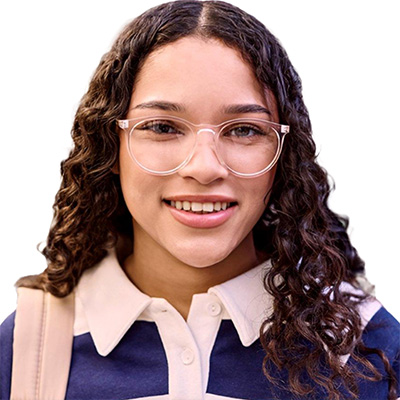What is Bookshare and how can educators and students access its services?
Page 4: Bookshare Formats
 As you have learned, Bookshare provides AEM to meet the needs of a wide range of learners. Bookshare does so by making materials accessible on various devices and reading tools via three formats: digital text, braille, and audio. We discuss these formats in more detail below.
As you have learned, Bookshare provides AEM to meet the needs of a wide range of learners. Bookshare does so by making materials accessible on various devices and reading tools via three formats: digital text, braille, and audio. We discuss these formats in more detail below.
Digital Text
Because digital text is the most flexible AEM format and meets the myriad needs of students with print disabilities, it is the most used Bookshare format. Students can customize digital text on a computer, tablet, or smartphone. For instance, students who require large print can increase the font size of digital text. Students can also simultaneously view and listen to digital text using the features of text-to-speech technology.
Although students can use many software tools and applications to interact with digital text, the free Bookshare Reader tool offers a seamless and customizable reading experience. Available on web browsers and as a mobile app, the Bookshare Reader allows students to:
- Listen to books in high-quality audio
- Enable automated word-by-word highlighting to follow along with audio
- Adjust reading speed, voice, pitch, and volume
- Adjust font size, colors, and contrast
- Navigate books by page and chapter
- Sync across devices so they can resume reading on any device
The video below demonstrates some ways to use the Bookshare Reader to personalize reading experiences (time: 2:02).
Transcript: Read What You Want, Where You Want with Bookshare Reader
A montage featuring a young girl in a field reading with a smartphone, a young woman on the street and reading with a tablet, and a young boy sitting on a park bench also reading with a tablet.
Read what you want, where you want with Bookshare Reader.
A young boy sits in front of a laptop with Bookshare Reader open on the screen. Behind him is an animated scroll featuring several e-books that are available in the Bookshare library.
Bookshare Reader opens the door to millions of e-books and easy-to-read formats and lets you read in ways that work for you.
Listen to books in high-quality audio.
A woman explores the custom settings menu in Bookshare Reader on her laptop.
Follow along with karaoke-style highlighting.
Adjust reading speed, voices, fonts, and colors.
Read and access math equations using MathML.
[Text-to-speech software]: X subscript one baseline plus 457 six subscript three baseline negative.
A close-up shot of an e-book being downloaded in the Bookshare Reader mobile app.
Download books and read offline on smartphones and tablets.
A woman checks the time on her watch and transitions from reading on a laptop to a smartphone.
Stop reading and pick up where you left off across devices.
An animation featuring the Bookshare Reader suite open on a MacBook, an Android smartphone, and an Alexa smart speaker.
Available on web browsers, iOS and Android tablets and smartphones, and Alexa enabled smart speakers.
A montage featuring a child reading in a classroom, a senior man reading on his couch, a teenage girl reading in her living room, and a young man reading on a moving train.
Whether you want to read for school or relax to the latest bestsellers, read what you want, where you want with Bookshare Reader.
An animation of the Bookshare logo.
Let’s take a look at how Thomas and Liza read using Bookshare’s digital text formats.

At school, Thomas uses assistive technology to read class materials using digital text. He views materials on a tablet and uses an adaptive switch to turn the digital pages and navigate the novels he is reading.
adaptive switch
A device that allows individuals with physical disabilities to operate various electronics using their range of movement.

During independent reading, Liza can choose from a range of high-interest books that she opens in the Bookshare Reader on her laptop. In the classroom, Liza uses headphones to listen to the book, which supports her ability to comprehend the story. Additionally, she follows along with the text on the screen as each word is highlighted in real time. This helps Liza connect the spoken and written words, supporting her development of word recognition skills.
Braille
Students with visual impairments (e.g., blindness, low vision) can access Bookshare materials in braille in a variety of ways, such as:
- Braille that has been transcribed and embossed onto paper using a braille embosser
- A specialized assistive technology device, such as a braille notetaker or refreshable braille display, which opens a file (e.g., Word document, Braille Ready Format [BRF])
braille embosser
A specialized printer that converts text into braille cells on paper.
Braille Ready Format [BRF]
A digital file that can be read using an electronic braille display or embossed onto paper for people with visual impairments.
Let’s take a look at how Gema reads using braille formats.

In the past, Gema’s teacher embossed most of her print materials into hard copy braille books, but this has become challenging now that Gema has multiple textbooks for her high school classes. Gema now uses BRF files to read books on a refreshable braille display. When she connects this device to her computer, she can tactilely read one line of braille at a time, which updates as she moves through the text.
Audio
Bookshare materials are also available in audio formats (human narrated or synthesized speech) that readers can listen to on a smartphone, tablet, or computer media player. However, readers cannot view any text through these formats. Let’s take a look at how Gema and Thomas read using audio formats.

For leisure reading at home, Gema usually prefers to listen to books rather than read them in braille because audio formats are more portable than bulky embossed books or a refreshable braille display.

Even when Thomas doesn’t have access to a computer, he can listen to audio formats anywhere using his smartphone and earbuds.
Keep in Mind
The best format for a reader will vary depending not only on their individual needs but also on the content area, the type of reading task, and the environment. These considerations can also evolve and change over time. When students are familiar with the different options available for reading Bookshare materials, they can exercise more agency over their own learning by choosing the most appropriate format and using the most effective tools.
In the interviews below, Sarah Caswell and Brian Meersma discuss the flexibility of the formats offered by Bookshare and how students can customize the features to meet their individual needs.
Transcript: Sarah Caswell
Accessible materials aren’t always available in schools and districts, but Bookshare provides equitable access.
When needing braille materials with the Bookshare library, you have access to over one million book titles, including textbooks instantly translated to braille, that students can use on their refreshable braillers or can be printed on an embossing printer. It’s instant access to any book title. It’s amazing. If your student uses an external switch or button to activate choices, their literacy materials, or eye gaze technology for making selections, the Bookshare web reader pairs seamlessly with this. Bookshare can even be used with the Alexa for any kind of voice control access. There’s also almost an endless way you can customize the actual web reader online with preferred colors, different contrast combinations, font preferences, spaces between lines, words, margins—all of it so that your learner is able to customize their own visual processing. It’s helpful to give the student that level of autonomy in their own education, and it’s going to help motivate them through some of these struggles that they’re having.
And on top of everything that I just pointed out, you can also utilize Bookshare in creating materials. So if you’re having students who need textured materials, raised materials, cleared out backgrounds—whatever you’re doing to create—it’s great as a tool for teachers, assistants, therapists, everybody.
Transcript: Brian Meersma
The text-to-speech, together with the highlighting, that was really helpful for me. And I started off very slowly with the text-to-speech voice going slowly, and I was able to get accustomed to that way of reading. And then as I got more comfortable with it, I was able to speed up to the speed that my peers were reading at and then eventually even speed up beyond that, which was really helpful when I had a lot of textbooks to read in school. Being able to see the words as they were spoken, I think, really helped me become more familiar with how different words looked. So then in situations where maybe I was just out and about and reading something quickly as I passed by, or something like that, I was able to recognize more words. So it really helped me not only be able to read the textbooks that I wanted to with the text-to-speech but also to be able to recognize words and improve my reading when I didn’t have technology. I also use it for pleasure, and oftentimes I’ll use the same highlighting and text-to-speech while I’m maybe lying in my bed or at home. But I also enjoy just listening to the books now. I’m so used to the text-to-speech voices that it just sounds natural to me and I don’t really think twice about it. So if I’m out on a walk or if I’m on the train, listening to a book for pleasure is really great.

